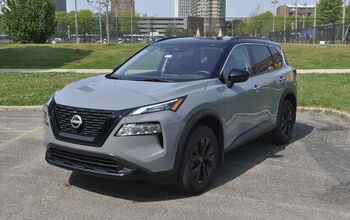2021 Dodge Charger and Challenger: Out With the New, In With the Old (Platform)?

When the first LX-platform Chryslers appeared in late 2004, buyers who had long grown wary of the automaker’s products took solace in the fact that the new 300 and Dodge Charger/Magnum borrowed so many components from bedmate Mercedes-Benz.
While not a direct carryover, the front and rear suspension, floorpan, and five-speed automatic transmission (among other items) all boasted German heritage. DaimlerChrysler found itself with a hit on its hands. Thirteen years later, after many updates and styling refreshes, LX cars still trundle off Fiat Chrysler’s Brampton, Ontario assembly line and into the waiting arms of North American traditionalists.
It was long expected that, after FCA hit snooze on a planned 2019 platform swap, we’d see new underpinnings for the old rear-drivers by 2021. Hold your horses, says CEO Sergio Marchionne.
The executive, who revealed the company’s new five-year plan on Friday (sans Chrysler, Dodge, and Fiat), suggests the future Dodge Charger and Challenger might stick with the current platform, albeit in heavily modified form.
Side note: the 300 is all but guaranteed to die, as per earlier remarks by Marchionne.
In the company’s last five-year plan, the LX cars were poised to gain Italian architecture for the 2019 model year, most likely the rear-drive Giorgio platform used by the Alfa Romeo Giulia. Last year, however, Automotive News reported that the Maserati Ghibli’s underpinnings would set up shop beneath the American full-sizers.
That’s a problem, as the Ghibli’s now expected to adopt the Giorgio platform towards the end of the automaker’s five-year planning window. In other words, right around the time the next-generation Dodges roll out of Brampton.
Comments reported by Motor Authority late Friday show FCA has second thoughts about the Giorgio platform.
“We may not necessarily have to go as far as the Giorgio architecture for Dodge as long as we are willing to commit to a significant upgrade to the current architecture to make it competitive,” said Marchionne. “That’s something that’s already started.”
He continued: “Certainly by the time we finish with that architecture, you will not recognize its origins. We may maintain its bare-bones structure.”
Marchionne implied that the Italian platform might not be the best fit for models boasting V8 engines of up to 707 horsepower. “The problem with Giorgio is from size and capability standpoint it reflects much more of a European performance requirement than it does the American heritage of Dodge,” he said.
Without giving a timeline for the revamped platform’s completion, we’re left assuming the 2021 date is still in play. Should FCA go this route, it means the next generation of cars could maintain the current generation’s generous proportions, though perhaps not their weight. A diet seems unavoidable. It’s necessary if FCA wants to offer, say, a turbocharged 2.0-liter four-cylinder with eTorque mild hybrid assist in the future lineup.
Let’s hope the engineers erase an Achilles Heel in the process. Meaning, of course, the Challenger’s dismal performance in the small overlap front crash test.
[Image: Fiat Chrysler Automobiles]

More by Steph Willems
Latest Car Reviews
Read moreLatest Product Reviews
Read moreRecent Comments
- MaintenanceCosts Nobody here seems to acknowledge that there are multiple use cases for cars.Some people spend all their time driving all over the country and need every mile and minute of time savings. ICE cars are better for them right now.Some people only drive locally and fly when they travel. For them, there's probably a range number that works, and they don't really need more. For the uses for which we use our EV, that would be around 150 miles. The other thing about a low range requirement is it can make 120V charging viable. If you don't drive more than an average of about 40 miles/day, you can probably get enough electrons through a wall outlet. We spent over two years charging our Bolt only through 120V, while our house was getting rebuilt, and never had an issue.Those are extremes. There are all sorts of use cases in between, which probably represent the majority of drivers. For some users, what's needed is more range. But I think for most users, what's needed is better charging. Retrofit apartment garages like Tim's with 240V outlets at every spot. Install more L3 chargers in supermarket parking lots and alongside gas stations. Make chargers that work like Tesla Superchargers as ubiquitous as gas stations, and EV charging will not be an issue for most users.
- MaintenanceCosts I don't have an opinion on whether any one plant unionizing is the right answer, but the employees sure need to have the right to organize. Unions or the credible threat of unionization are the only thing, history has proven, that can keep employers honest. Without it, we've seen over and over, the employers have complete power over the workers and feel free to exploit the workers however they see fit. (And don't tell me "oh, the workers can just leave" - in an oligopolistic industry, working conditions quickly converge, and there's not another employer right around the corner.)
- Kjhkjlhkjhkljh kljhjkhjklhkjh [h3]Wake me up when it is a 1989 635Csi with a M88/3[/h3]
- BrandX "I can charge using the 240V outlets, sure, but it’s slow."No it's not. That's what all home chargers use - 240V.
- Jalop1991 does the odometer represent itself in an analog fashion? Will the numbers roll slowly and stop wherever, or do they just blink to the next number like any old boring modern car?































Comments
Join the conversation
If only FCA had an existing sporting RWD sedan platform. *Looks at Alfa Romeo. *Looks at Maserati. Hmmm....
LX cars still trundle off Fiat Chrysler’s Brampton, Ontario assembly line" Uh no. 2006-2010, LX Charger 2011-Present, LD Charger 2008–2014, LC Challenger 2015-Present, LA Challenger